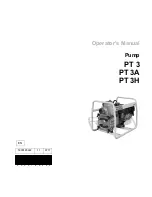
1. This air ratchet is designed to speed productivity, not for high torque applications such
as head bolts, lug nuts, etc. DO NOT USE THIS RATCHET UNDER POWER TO
BREAK FASTENERS LOOSE. Loosen fasteners by hand without depressing throttle.
Once loose, depress throttle to speed fasteners in or out. Always perform final torque
tightening by hand.
2. Use only impact sockets designed for impact wrenches.
3. This ratchet is rated to 3/8 in. USS bolt size. Rating will decrease for U-Bolts, Long Cap
Screws, Spring Fasteners and rusted or corroded fasteners. All of these factors absorb
power and reduce torque capability.
4. Always use approved eye and ear protection when using air powered tools. If
raising dust/debris, wear a suitable mask. Do not wear loose clothing or jewelry.
5. Always operate tool a safe distance from yourself and others in the work area. Keep
footing and balance at all times.
6. Make sure work piece is secure to allow safe operation of the tool with both hands. Do
not hold the work piece in your hand, lap or against any part of your body.
7. Make sure trigger is in the “off” position before connecting or disconnecting the
tool from air source. Disconnect tool from air source before changing
accessories, performing service and when not in use.
8. Follow air source manufacturer's directions for connection of regulators, filters and other
accessories to air source. Do not install quick couplers directly at tool air inlet. This
causes inlet failure due to excess weight and vibration. Use a whip hose between tool
and quick couplers.
9. DO NOT OVERLOAD! Do not force tool. Match tool capacity to work load requirement.
Use tool within its rated capacity and only for its designated purpose. Overloading air
tools will cause premature wear and/or permanent damage of internal and
external drive parts and will void warranty.
10. Inspect hoses and fittings for wear and damage prior to using tool. Do not carry or drag
tool by the air hose. Keep air hose free from obstruction, twisting and binding.
1. This air ratchet is designed to speed productivity, not for high torque applications such
as head bolts, lug nuts, etc. DO NOT USE THIS RATCHET UNDER POWER TO
BREAK FASTENERS LOOSE. Loosen fasteners by hand without depressing throttle.
Once loose, depress throttle to speed fasteners in or out. Always perform final torque
tightening by hand.
2. This ratchet is rated to 3/8 in. USS bolt size. Rating will decrease for U-Bolts, Long Cap
Screws, Spring Fasteners and rusted or corroded fasteners. All of these factors absorb
power and reduce torque capability.
3. Use the simplest socket to wrench hook-up. Any additional extensions, u-joints or
adaptors will absorb power and reduce torque capability.
4. Forward/Reverse Lever. Select “F” for Forward (Clockwise) or “R” for Reverse (Counter-
clockwise) operation. Do not attempt to change direction while tool is running.
5. If fastener bogs, slows or binds the tool, use a larger size ratchet tool with a higher
torque rating. Overloading this tool will cause premature wear and/or permanent
damage to internal and external drive parts and will void warranty.
IMPORTANT SAFETY INFORMATION
OPERATION
Clean air of correct air pressure is recommended for the power supply for this tool. A
maximum of 90 PSI at the tool is recommended for most air tools of this class. Check
specifications section for recommended pressure. (Depending on length of air hose and
other circumstances, air pressure at compressor may need to be increased to 100 PSI to
ensure 90 PSI at the tool.)
Water in the air hose and compressor tank contributes to reduced performance and
damage of the air tool. Drain the air tank and filters before each use and as necessary to
keep the air supply dry.
Hose length over 25’ causes loss in line pressure. Increase hose I.D. or increase
compressor pressure to compensate for the pressure loss. Use an in-line pressure
regulator with gauge if air inlet pressure is critical.
AIR SOURCE
Oil tool before each use. 4 to 5 drops of a good grade Air Tool Oil placed in the air inlet is
sufficient. Use proper air pressure and CFM rating listed for this tool.
Drain water from hoses and compressor tank. Water in the air supply line will cause
gumming and loss of power. Clean the air filter on the supply line and flush the tool with
gum solvent or a 50/50 mix of air tool oil and kerosene. It may be necessary to
disassemble the tool to properly clean and re-lubricate.
LUBRICATION & MAINTENANCE
Forward/Reverse Lever
Air Inlet
Trigger
INSUFFICIENT POWER:
Probable Cause
Solution
Dirty or clogged air passages ......... Flush and lubricate tool, drain air tank and supply line
Insufficient air supply ...................... Increase line pressure, Make sure compressor
matches tool's air pressure and consumption needs
Air leakage...................................... Use teflon tape at all fittings and joints. Check tool for
worn or damaged O-rings & seals.
Worn/damaged wear & tear parts ... Replace as necessary.
Tool matching ................................. Be sure you are using a tool suited for the torque
requirements of the job at hand.
TROUBLESHOOTING
Motor
Oil
Trans.
Fluid
Brake
Fluid
Water
Whip
hose
Air Tool
Oil
Yes
No




















